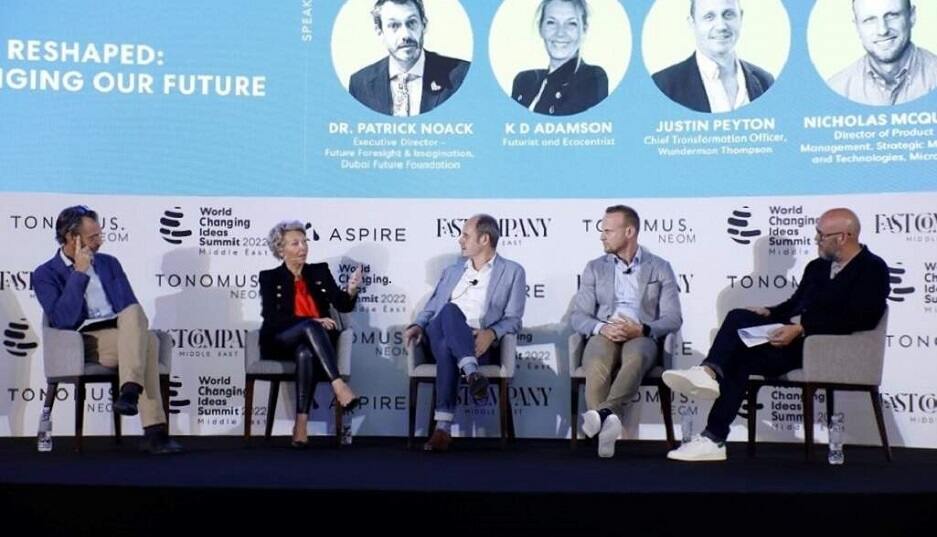- | 9:00 am
Human-machine collaboration can shape a better future. So what’s stopping us?
At the World Changing Ideas Summit, experts said the world is on the cusp of seeing a significant transformation, particularly in the commercial sciences

Much has been talked about technological innovation and how it’s drastically changing the world we live in, but the fascinating aspect is how humans and technology have blended to solve pressing problems.
Human-AI-powered machine collaboration, also called collaborative intelligence, has transformed how we live, work, and conduct business.
“Large-scale AI capability has helped humans co-reason with AI more effectively and solve problems. This is what’s exciting about the future,” Nicholas McQuire, director of Product Management, Strategic Missions, and Technologies at Microsoft said at the World Changing Ideas Summit.
McQuire said human and AI co-reasoning has birthed new scenarios and prospects creating a new category of work called “intelligence working”.
A prime example is how it augments the firefighters’ intelligence, equipping them with real-time information and decision-making capacity. Soon firefighters will be able to co-reason with AI connected over 5G, deploy autonomous systems and also have 5G-connected robots to coordinate different tasks, McQuire added.
Co-reasoning has become essential in business and creative ideas.
“The problems with the world are not going to be solved by one person coming up with a great idea but by collective intelligence. But we’ve built models designed to reward individual intelligence and individual input and protect IP around that,” said Justin Peyton, chief transformation officer of Wunderman Thompson.
Moreover, with NFTs being seen as an ownership protocol and Web 3.0 as a relationship protocol, technologies can bring different ideas together and reward more collaborative thinking in a valuable way. All of these can potentially build a much larger network effect of thinking.
“Collective thinking has the power to solve problems far better than anyone individually,” added Thompson.
BUT ARE WE READY FOR IT?
While the idea of globally crowdsourcing ideas for innovation can be quite tempting, there is always a possibility that innovation can be held back by companies wanting to hold on to profits.
“Many people want you to believe that the future is a technology problem. Even though it’s a possibility, that’s not the only point of focus,” said K D Adamson, futurist and ecocentrist. She added that it is crucial to understand the underlying root cause of this problem, which has a massive range of serious externalities, whether people’s health, inequality, or misinformation.
Today, companies have to take a stand and are no longer allowed to remain neutral. Adamson explained how stakeholders have to stand up for their beliefs, and those values are only sometimes aligned. This spills over to technology because the strategic decisions about which technology you adopt now have to consider diverse geopolitical interests.
“There’s a lot to unpack here. We’re moving into a new moral age, which has huge potential positives. But it can also be very dangerous,” said Adamson.
BUILDING A BETTER FUTURE
Amidst the debate about powerful technologies, what needs to be determined is what we do with that kind of technology and what kind of future we want.
It’s important to take a step back to assess and identify the direction the world needs to move to shape a better future.
“We need to understand whether creating success inadvertently creates some damage that needs to be repaired going forward. Right now, we are at a watershed moment where we have lived through three-and-a-half consecutive industrial revolutions, and we have emitted a large amount of greenhouse gas emissions,” said Dr. Patrick Noack, executive director of Future Foresight and Imagination, Dubai Future Foundation.
To reverse this effect, technology would play an essential part. “We’re going to be at that moment where a new industry, a new way of making money and of driving economies, is to reverse the processes of damage that have been activated over the past 250 years.”
“We need to rethink some success metrics, and GDP just doesn’t cut it anymore. It’s a blunt tool,” added Noack.
As we move into a new age, technology is already being applied to tackling some tough problems, and experts believe that the world is on the cusp of seeing significant transformations, particularly in commercial sciences.
“The world is shaping the future differently because we’re all contributing to futures in our own ways. What gives me hope is that people are not going to just sit and wait for the next algorithm to solve their own problems. People can solve their problems going forward,” said Noack.








































